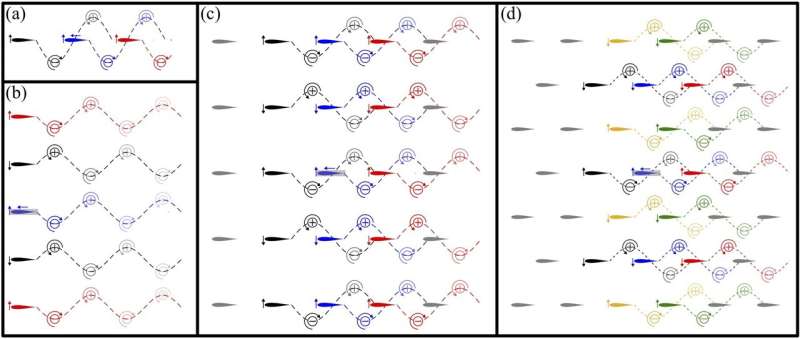Researchers rank 'smartest' schools of fish when it comes to travel formations

The concert of motion that fish schools are famous for isn't merely an elaborate display of synchronized swimming. Their seemingly telepathic collective movement is part of a time-tested strategy for improving the group's chances for survival as a whole, from defense against predators to food-finding and mating.
A study published in Physical Review X is offering new details that show how the aquatic flows created by certain schools of fish can benefit each of its individual members in yet another way—hydrodynamically.
A research team from New Jersey Institute of Technology (NJIT) and New York University (NYU) has showcased a new mathematical model capable of determining what formations give a school's swimmers the biggest advantage when it comes to energy efficiency and speeds, particularly when compared to school-less fishes.
The researchers say the study offers a physical picture that illustrates how swimmers in fish schools are influenced through the constant connection between each swimmer's flapping wings and the persistent flow vortices generated by the collective.
"There is a lot of scientific literature that has focused on the dynamics of fish schools and social interactions that shape them, such as the need to take up formations for predator avoidance for instance," said Anand Oza, assistant professor at NJIT's Department of Mathematics and one of the study's authors. "Often neglected, however, has been fluid dynamics ... 'can fluid flows actually influence the structure of schools?'. What I find exciting is that with this study we can now quantitatively point to how hydrodynamics can help or even hinder a school."
The team examined four common fish school formation types in motion: in-line formations, single-file "phalanx" formations, rectangular "lattice" formations; and diamond lattice formations.
By applying experimental data from previous studies conducted at NYU to their model, the team captured a range of subtle hydrodynamic interactions that occur within various fish schools, showing how much energy was exerted by each fish from their flapping movements as they swam within their formation. The team's model also kept track of the forces due to small whirlpool-like vortices the swimmers shed with every stroke, showing how much the fishes were propelled along by vortex flows generated by their schoolmates.
Overall, the team's computer simulations revealed that schools formed in a single-line across (phalanx) received marginal speed and energy savings over solitary swimmers, while in-line and rectangular lattice formations offered substantial improvements. However, the team observed that fish organized in a diamond lattice formation received the greatest hydrodynamic advantage.
"Finding that the diamond formation is best was not altogether surprising, but what we learned is that all diamonds are not equal ... the geometry does matter. Generally, the thinner the diamond formation, the better the performance," explained Oza.
Oza now says their team hopes to develop their model further to study similar dynamics in bird flocks. The results could have engineering applications in energy harvesting and propulsion, perhaps in ways that may be useful for developing more efficient wind farms.
"We need to further validate our model and conduct more tests, but ideally I could see conceptually similar models used to help determine how to arrange wind turbines together to get the best output of energy," said Oza. "We'd also like to use this model to look how vortices and fluid-mediated memory can influence the collective behavior of densely packed or disordered schools and flocks. That is an exciting look forward that hasn't been explored a lot."
More information: Anand U. Oza et al, Lattices of Hydrodynamically Interacting Flapping Swimmers, Physical Review X (2019). DOI: 10.1103/PhysRevX.9.041024
Journal information: Physical Review X
Provided by New Jersey Institute of Technology




















